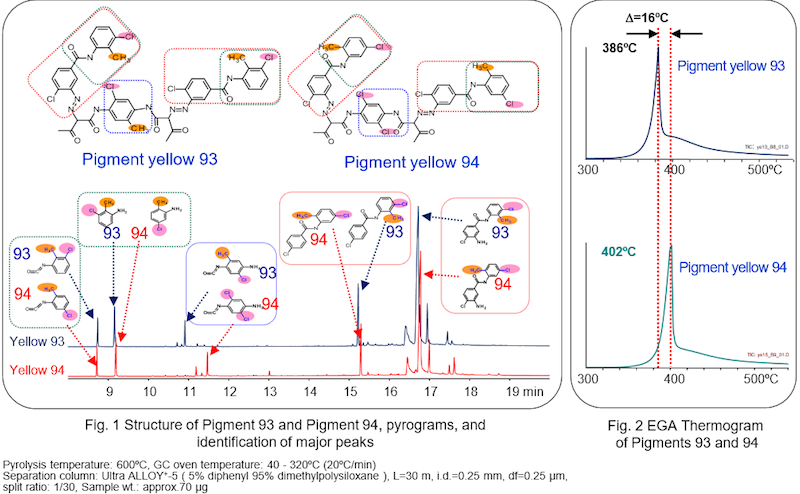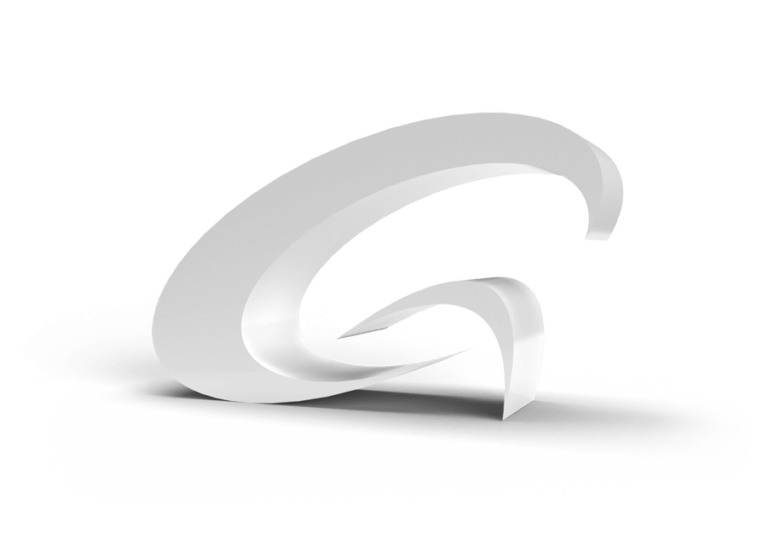
Organic pigments are widely used in paint and ink formulations. The analysis and structure elucidation of the materials is a big part of characterizing organic pigments. This can be challenging because they are 1) insoluble in organic solvents and 2) many of them have similar structures. Most methods for determining organic pigments are based on solvent extraction, filtration and concentration. These traditional techniques can be cumbersome, time consuming, and produce analyst-to-analyst variability while producing data of limited value.
Frontier Py-GC/MS offers a revolutionary solution for charaterizing organic pigments in a complex matrix in paint, ink, and coating industry. Samples are analyzed directly; no pretreatment such as solvent extraction is necessary. Pyrolyzates are separated on a high-resolution capillary column and identified using both spectral (MS) and retention (GC) data. This technique can be used both qualitatively and quantitatively and allows multiple and customized analysis on the same sample. The advantages of this technique include enhancing efficiency, data quality, and quality assurance.
The Frontier pyrolyzer was used for analyzing relatively large-molecular-weight (MW approx. 1,000) nonvolatile pigments, including condensation disazo pigments with similar structures, azo lake pigments, and phthalo-cyanine pigments.
The first step in characterizing the organic pigments was Evolved Gas Analysis (EGA) technique. EGA provides a clear “picture” of the sample’s complexity. In this technique, the sample is dropped into the furnace which is at a relatively low temperature. The furnace is then programmed to a much higher temperature. Compounds “evolve” from the sample as the temperature increases and then a plot of detector response versus furnace temperature is obtained. In this study, The EGA-MS was performed by programming the furnace 100 to 600 ⁰C at 20 ⁰C/min.
The second step was to analyze the thermal zones of interest obtained from EGA thermograms. Pyrolysis-GC/MS at 600 ºC were performed on 35 organic pigments. F-Search, a search engine with 4 unique libraries manufactured by Frontier Labs, was used to create the organic pigment library and process the MS sample data. The spectral information from the Py-GC/MS analysis was incorporated into a searchable MS library using Frontier F-Search engine. Additional organic pigments can easily be added. Such a “pigment” library can be used to identify pigments in an ‘unknown’ sample.
The results obtained by the EGA-MS and Py-GC/MS analysis of Pigment yellow 93 and Pigment yellow 94 are shown below. The molecular structures of these two pigments have similar structures. This data was used to construct a database to identify unknown pigments which have similar structures. When characterizing organic pigments that contain multiple pigments, the Py-GC/MS is extremely useful since the pyrolyzates of each pigment can be separated, identified, and quantitated.

Today, more laboratories are integrating the Frontier EGA/PY-3030D multi-shot pyrolyzer into their mainstream analytical protocols due to the advantages and immediate quality improvements this technique provides. Not only is it a powerful instrument for characterizing organic pigments, but virtually any material (gas, liquid, or solid) can be chemically characterized using this technique. Frontier Multi-Shot Pyrolyzer guarantees reproducibility and accuracy where every facet of the system is designed to ensure reliability and data quality. All surfaces in contact with the sample are quartz or deactivated stainless steel. There is NO transfer line and NO cross contamination!
The system also increases laboratory productivity as sample preparation takes less than five minutes, and the low mass ceramic furnace heats and cools in record time for efficient and continuous sample analysis. This technique requires small amount of sample which reduces the cost of sample shipping, handling, and disposal. In addition, NO solvent is required when analyzing a sample.
Frontier Pyrolyzer coupled with a GC/MS offers the following:
References:
Flexible financing, technical services, and refurbished instruments.
Everything you need to advance your lab’s success – all in one place.
8301 New Trails Drive, Suite 100, The Woodlands, Texas 77381
Complete this form below to sign up and we will reach out to you with instructions
